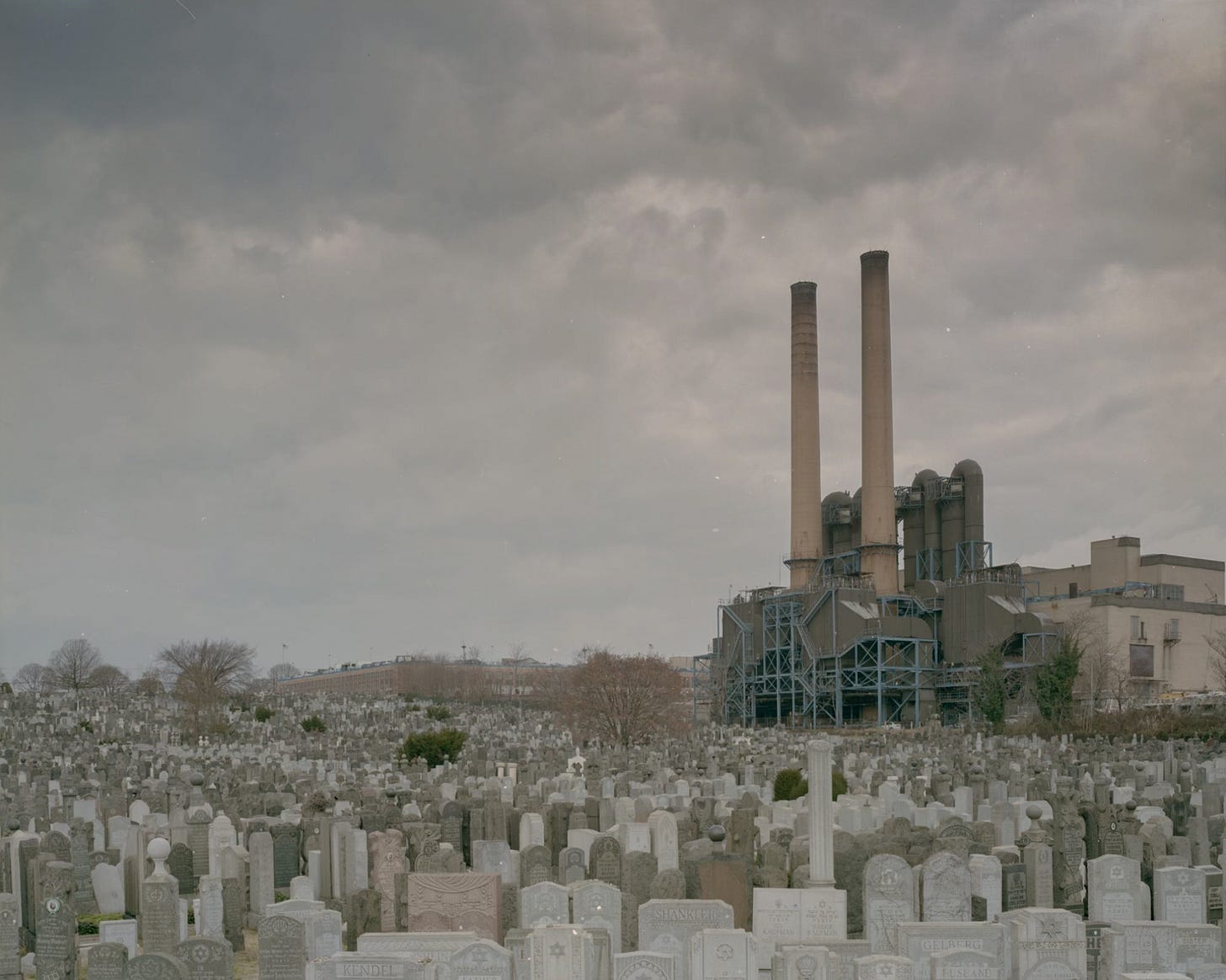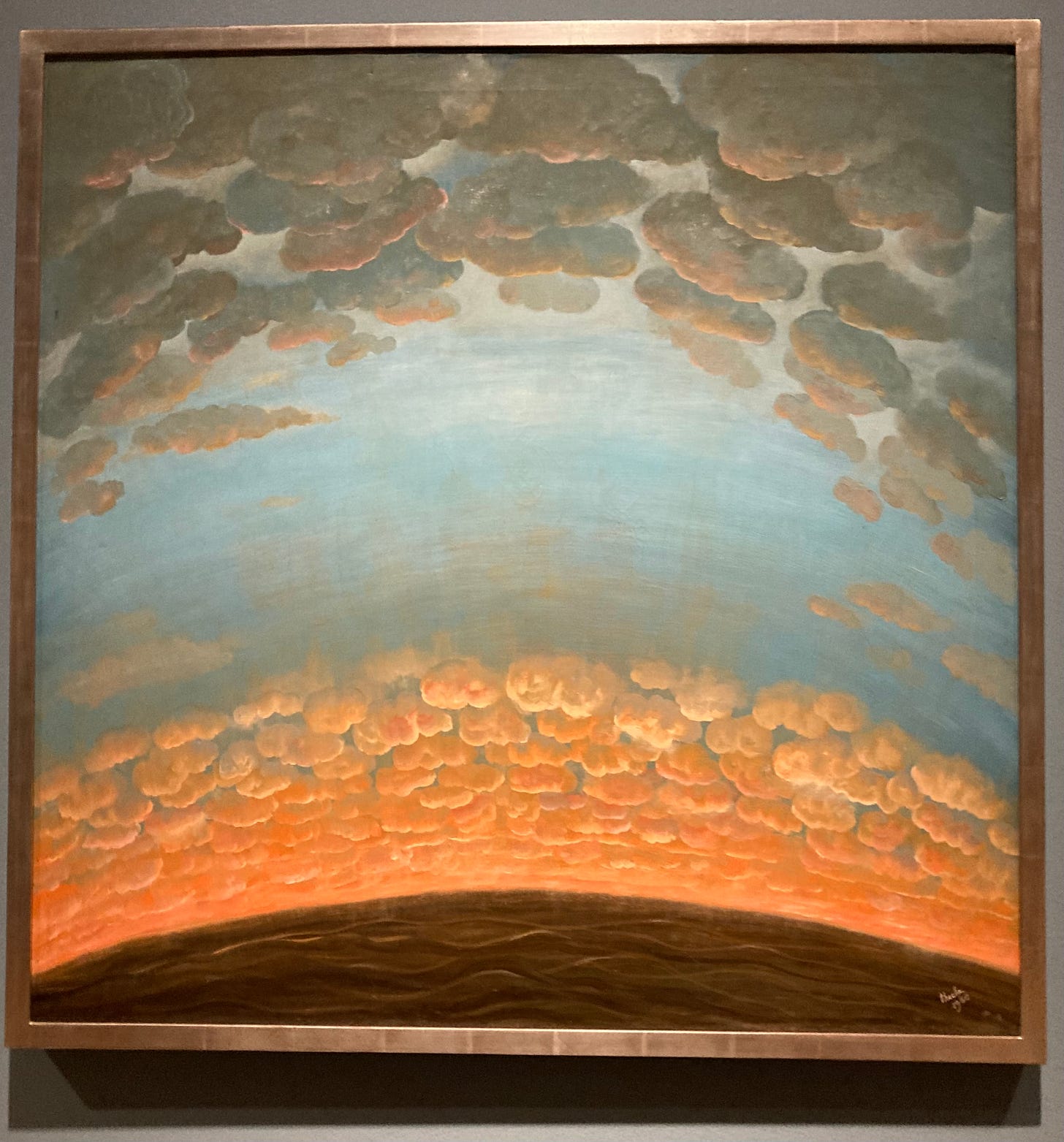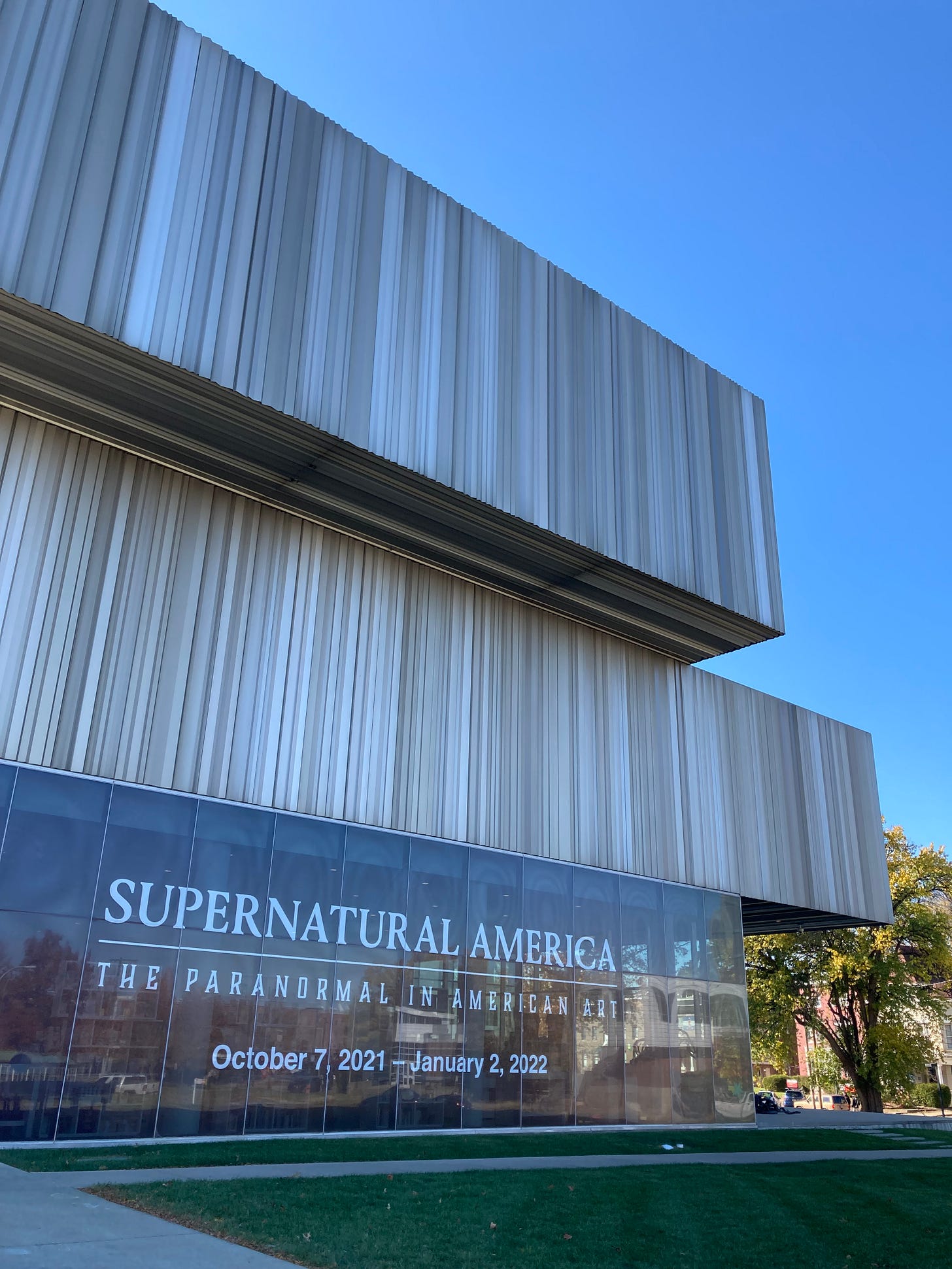America Is a Haunted Place
Season 8, #1: A Stargazing intro to a series on paranormal art and literature
“The reality of art is the reality of the imagination.”
—Jeanette Winterson1
ONE YEAR AND THREE months into the COVID-19 global pandemic, I got bitten by a different bug—one that lodged itself in my mind and wouldn’t let go.
As my former mentor Ray Bradbury once wrote: “…my stories have led me through my life. They shout, I follow. They run up and bite me on the leg—I respond by writing down everything that goes on during the bite. When I finish, the idea lets go, and runs off.”2
I call my bites “Big Stargazing Moments” and man, I sure got pummeled on Sunday, May 23, 2021.
Why then? And why was it Stargazing?
I’d just read an article in the Minneapolis Star Tribune on our city’s art museum launching an exhibition they were sending on tour called “Supernatural America: The Paranormal in American Art.” The Minneapolis Institute of Art (or Mia) contemporary art curator at the time was Robert Cozzolino—the veritable force of nature behind a show that would launch in June at the Toledo Museum of Art in Ohio, then travel to Louisville, Kentucky’s Speed Art Museum in October before returning to Minneapolis in 2022.
Why—you might wonder—was it such a burning topic for me?
Oh, my. It pushed all my buttons growing up. You see, I was a strange kid. Terrified of dying in my sleep, I was fascinated by my fears enough to stay up late watching horror films on TV. Go figure.
So, I’m ready to disappoint you now.
I have nothing profound to admit: I’ve never seen a ghost, wouldn’t know supernatural from Super Freak, and don’t believe UFOs (or UAPs as they’re now called) are extraterrestrial visitors from distant planets.
Sorry, but that’s where the conversation ends.
What I am happy to talk about is art and literature (and, of course, the history and culture that contributed—or didn’t—to their creation). When I saw the Mia’s exhibition catalogue, salivating at the opportunity to see the works IRL, stories came to mind from the vast canon of American literature that might link up with the art. I began to formulate a long-form piece that I decided I would sell to any magazine or journal that would publish it. And I contacted the Mia’s marketing department to see about getting interview time with Mr. Cozzolino.
So what happened? Did I write the article for the Mia? Did it get published?

Well, it’s a complicated story of self-marketing gone awry, since the work I was willing to put in didn’t square with the powers that be, which means, “I own the words and ideas” but thank you for the art and inspiration. I don’t mean to sound bitter, but I was frustrated. I made notes, had some interviews, went to the exhibition in Louisville and Minneapolis, and, well, that was that.
That said, the exhibition was one of the finest I’ve ever seen. Thrilling. Brilliant, truly. And funny enough, it still haunts me. So I mused, why not just publish it here on Substack? Go personal with it and dive deep? Those questions frankly thrilled me and … here we are.
But let’s start with that horror-film-watching kid.
I was blessed to be born into a family of readers—both Mom and Dad were fond of literature, art, and music and stocked our house with the best: Melville, Twain, Poe, Hawthorne, as well as encyclopedias and magazines. As a kid, I didn’t need a library, I just went downstairs and perused Dad’s books. One in particular grabbed me and wouldn’t let go: The Collected Tales and Poems of Edgar Allan Poe.
Whoa, Poe was creepy. Good stuff.
Later on, with pockets full of allowance money, I bought my own books, or Grandma Hazel gave me books, such as Alfred Hitchcock’s collections of mystery and ghost stories. She read Agatha Christie novels like most people consume candy and was happy to share with her grandson something in common. I loved her.
One of the books I bought, in paperback of course, was titled Strangely Enough! by C.B. Colby and I couldn’t put it down. In the mid-1970s, while babysitting a neighbor’s two children, Mark and Jenny, I brought it along and read to them while sitting. They demanded I come back and read to them again. The stories were that good.
The more this fascinated me the more concerned my parents became. “Don’t get your head stuck in the occult!” they chided. I knew better. This was my heart’s blood: great storytelling. Something I was sure would last forever.
So, here we are, with art from a COVID-19 period exhibition and a dying America in in mid-2020s, with its attendant ghosts, monsters, demons and devils. A country as vast and desolate as a moon orbiting Jupiter, or a glistening stone in a lone brook somewhere in Ohio.
My vision for “America Is a Haunted Place” includes four parts, of which this introduction is one. The remaining three are, Episode 2: “Strangers in a Strange Land” about the founding myths and legends of America, Native American tales and ghost stories, works by early American authors Nathaniel Hawthorne and Washington Irving, leading up to our master of American horror, Edgar Allan Poe in mid-century.
At that point we turn it over to Episode 3: “There’s a Darkness on the Edge of Town,” of course nipped from Bruce Springsteen, but I think it’s better than my original title of “Ghost Towns of the Far West” since the take here isn’t just about frontier towns or ghost stories. The focus is the beating heart of my argument: America became haunted—truly haunted—when it became modern. Modernity is the demon in the country’s narrative arc.
We’ll conclude with more science fiction and fantasy in Episode 4: “Somewhere Under the Rainbow,” which in the Supernatural America exhibition was called “Parallel Universes” and included even more modern takes like alternative worlds, UAPs or UFOs, spectral beings, and a crazy little thing called the “Multiverse.”
Crackin’ good fun!
What follows are teasers for what’s to come in the next three episodes, which will dive more deeply into the themes of America as a haunted place.
If you’re new to StoryShed, please consider subscribing so you don’t miss an episode.
Strangers in a Strange Land
“Then for the first time he was conscious of a sense of the supernatural and drove home as rapidly as his willing horse would go.”
—Ambrose Bierce3
IF YOU WANT TO read a ghost story that’ll knock you for a loop, look no further than Ambrose Bierce’s 1888 short tale, “Present at a Hanging.”
But why do I pair it with Grant Wood’s 1935 painting “Death on the Ridge Road”?
Well, let’s dig into that.

The supernatural comes out of left field. Sometimes you can’t gauge anything is abnormal until hours, days, months or—hells bells—even years after the event.
In Bierce’s tale, the story opens in 1853, near Lebanon, in northwestern Iowa. Bierce is our narrator, and he tells us of a lone farmer named Daniel Baker who lives there, “Old Man Baker,” as the locals call him. Old Man Baker has a reputation: People seem to “disappear” on his farm. The townspeople suspect he’s robbing and murdering itinerant peddlers.
Seven years later (which would be in 1860), one Baptist minister, the Reverend Mr. Cummings, is driving his horse and trap by Baker’s farm on a moonlit night, approaching “a little bridge across a dry ravine.” He’s whistling to himself and feeling all is well in the world. But something makes him stop on that bridge.
In Grant Wood’s 1935 painting “Death on the Ridge Road,” we’re projected into the sky almost like a 21st century video drone, high above a hill that’s ominously lit with late afternoon light and a storm approaching from the right. A sedan veers around an oncoming truck, another car just behind it. The telephone poles loom over the hillside like crucifixes on Golgotha centuries before. It’s a 1930s stretch of road that might be rutted with rain and mud, depending on the weather. What’s ahead is unknown.
Something is about to happen—and it’s not good.
Meanwhile Rev. Cummings meets a peddler on the bridge, with “something strapped on his back and [carrying] a heavy stick…his attitude had in it a suggestion of abstraction, like that of a sleepwalker.”
Cummings is glad to see a traveler and invites him to join him in the carriage “if you’re going my way.”
This is America at a crossroads. That man on the road: Who is he really? What does he represent? Why is he there at all? The minister is confused.
When he looks again, the traveler is gone. “Then for the first time,” Bierce writes, “he was conscious of a sense of the supernatural and drove home as rapidly as his willing horse would go.”
That, my friends, is how reality goes south: What you thought you knew as truth is completely thrown out the window.
Rev. Cummings is the witness since he rides home and tells all, and it’s discovered that the man he met was found dead and hanging from a rope below the bridge—murdered by Old Man Baker, whose bones were found close by and, as is generally agreed upon in the United States of America, was deemed killed by his own hand.
The killer and the victim haunt the same bridge in Lebanon, Iowa, to this day. About that I have no doubt.
—But what happened out on the Ridge Road?
It’s a question still left unanswered.
There’s a Darkness on the Edge of Town
“I confess that I would have gladly voted for the creature’s destruction. But who would shoulder the responsibility?”
—Fitz-James O’Brien4
IMAGINE YOU’RE IN BED and something suddenly lands on your chest and … it begins choking you to death.
What do you do?
Author Fitz-James O’Brien asked that humdinger of a Stargazing question back in 1859. Out of it he wrote a masterwork of horror fiction called, “What Was It?”
My companion Supernatural America artwork is by Iowan Marvin Cone, from 1938, titled “Anniversary.” Cone was born in Cedar Rapids in 1891 and was lifelong friends with artist Grant Wood. He died in 1965.
Emanating from Cone’s painting, a spectral being hovers near an open doorway leading up into utter darkness. What is the being—is it a ghost? Why is it waiting by the door? What does “Anniversary” mean?
“Anniversary” was among the paintings featured in the Supernatural America exhibition. When I saw it I immediately thought of the O’Brien story. Because of the painting’s slightly askew composition—as if the axis of the Earth has tilted to the right—the viewer gets an ooky sense of being untethered from reality, along with their curiosity aroused.
What is at the top of those stairs? Do I even want to find out?
In the O’Brien story, the narrator has been up late imbibing with his next door neighbor Dr. Hammond in their Twenty-sixth Street New York City tenement house. Word between them is: “Damnit, man, this place is haunted!” The two men continue their conversation over puffs of opium, during which Hammond asks our narrator, Harry, “What do you consider to be the greatest element of terror?”
Harry confesses it’s a question he’s never considered before. The doctor agrees and the sudden uneasiness they both feel leads them to retire to their separate rooms to sleep.
And that’s when things go very, very wrong.
“A Something dropped, as it seemed,” says Harry, “from the ceiling, plum upon my chest, and the next instant I felt two bony hands encircling my throat, endeavoring to choke me.” After struggling with the invisible intruder, Harry is able to pin it on the bed and call for help. Soon other tenants and Dr. Hammond appear and, in the gaslight, everyone is at last able to see—nothing on the bed. When the doctor goes to the bed at Harry’s request, “If you don’t believe me, convince yourself. Feel it—touch it!”
Whereupon Hammond does as requested and “a wild cry of horror burst from him. He had felt it!”
Fitz-James O’Brien’s story is well worth reading on your own, and later in Episode 3 of this series we’ll explore the story again along with other stories and accompanying artwork. The gist is that mid-nineteenth century, post-Industrial Revolution America is on the verge of modernism.
And when modernism kicks in, what we’ve built is what will likely kill us—or definitely haunt us in the end.
Somewhere Under the Rainbow
“…my fear of them and their fear of me became one same fear.”
—Ursula K. Le Guin5
FEAST YOUR EYES ON this wonder.

Based out of Chicago in the 1930s and ’40s, artist Julia Thecla’s work was described by the DePaul Art Museum as an “ethereal and sensuous portrayal of dreams, fairy tales, and planetary realms … extraordinary explorations of alternative social orders.”6
When I stood before her “In the Clouds” at Louisville’s Speed Art Museum in October 2021, I was stunned by its almost biblical-level beauty. Later I wondered what might join up in a literary way with it, and came across Ursula K. Le Guin’s short story “She Unnames Them.”
But first I had to track down some source material, specifically this crusty old chestnut:
“Then the Lord God said, ‘It is not good that the man should be alone; I will make him a helper fit for him.’ So out of the ground the Lord God formed every beast of the field and every bird of the air, and brought them to the man to see what he would call them; and whatever the man called every living creature, that was its name. The man gave names to all the cattle, and to the birds of the air, and to every beast of the field; but for the man there was not found a helper fit for him.”7
Le Guin’s tale veers off from the Bible with a more lighthearted spin.
After Adam’s done with his naming job, slinking off to his Eden man cave for a smoke break and brewski, Eve leads an all-hands meeting with Earth’s fauna and basically gives Adam’s designation disaster back to their original owners. In short, “What do you folks wanna call yourselves?”
Once achieved, Eve (who narrates the story) notices a shift in the planetary social order that God and Adam had already co-created:
“They [the Earth’s creatures] seemed far closer than when their names had stood between myself and them like a clear barrier: so close that my fear of them and their fear of me became one same fear. And the attraction that many of us felt, the desire to smell one another’s smells, feel or rub or caress one another’s scales or skin or feathers or fur, taste one another’s blood or flesh, keep one another warm—that attraction was now all one with the fear, and the hunter could not be told from the hunted, nor the eater from the food.”8
So, you might be wondering, how does Thecla’s “In the Clouds” tie in with Le Guin’s “She Unnames Them”?
Well, perhaps it’s an alternative take on an old story—a way of looking at the tired old order of things with fresh new eyes.
That’s what I’m hoping readers will enjoy in Episode 4 of this series.
At least that’s the challenge I’m laying down.
Conclusion
“ART IS VISIONARY; IT sees beyond the view from the window, even though,” Jeanette Winterson writes in her essay, “the window is a frame.”
If America is indeed a haunted place, then perhaps the supernatural becomes the frame through which we can see it—warts and all—and the stories we tie to that vision just might expand our understanding of what it means to be an imaginative person in such a vast, diverse, and often cold and indifferent country.
“The artist need not believe in God,” she continues, “but the artist does consider reality as multiple and complex. …Art is not documentary. It may incidentally serve that function in its own way but its true effort is to open to us dimensions of the spirit and of the self that normally lie smothered under the weight of living.”9
In the series ahead, I’m hoping we can share some stories and images that “open to us dimensions of spirit” and leave behind—even if only for a moment—life’s heavy and suffocating aftereffects.
Let’s give Jeanette Winterson the last word:
The gate is open. Whether or not we go through is up to us, but to stand mockingly on the threshold, claiming that nothing lies beyond, is something of a flat earth theory.
The earth is not flat and neither is reality. Reality is continuous, multiple, simultaneous, complex, abundant and partly invisible. The imagination alone can fathom this and it reveals its fathomings through art.10
Notes and references
Much gratitude to photographer Rob Stephenson for use of his stunning Queens, NY, photo. StoryShed is also grateful to Chris Hahn for the heads up on the Supernatural America companion book by Robert Cozzolino, published by the University of Chicago Press.
In Episode 4: “Somewhere Under the Rainbow,” I hope to include portions of an phone interview with American horror literature anthologist and author S. T. Joshi from 2021. [Update 5/18/25: Hoping to update the 2021 interview transcript with a live Substack interview with Mr. Joshi after the series concludes. Stay tuned!]
“Imagination and Reality,” from Art Objects: Essays on Ecstasy and Effrontery by Jeanette Winterson (1997: Knopf Doubleday, New York, NY).
"Drunk, and in Charge of a Bicycle” from Zen in the Art of Writing by Ray Bradbury (1990: Capra Press, Santa Barbara, CA).
“Present at a Hanging,” by Ambrose Bierce, from Can Such Things Be? (2011: Library of America, edited by S. T. Joshi, New York, NY).
“What Was It?” by Fitz-James O’Brien, from American Supernatural Tales, edited by S. T. Joshi (2007: Penguin Classics, Penguin Group USA, New York, NY).
“She Unnames Them,” by Ursula K. Le Guin, from The New Yorker (Jan. 21, 1985).
DePaul Art Museum, “Julia Thecla: Undiscovered Worlds.” Retrieved Feb. 21, 2025.
Genesis 2:18-21, Revised Standard Version, 1962.
“She Unnames Them,” by Ursula K. Le Guin, from The New Yorker (Jan. 21, 1985).
“Imagination and Reality,” pp. 136-137.
Ibid., p. 151.














Can the exhibition book be viewed on line ?
Alfred Hitchcock’s collections of mystery and ghost stories. Wow, does that bring back memories! I also remember staying up late on Friday nights and watching old horror movies. Some kids latch on to those things, and I guess I too was one of them.
You've given us some good stories and artworks to explore. Looking forward to your next essays!